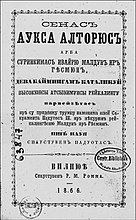Russification of Poles during the Partitions
The Russification of Poland (Polish: rusyfikacja na ziemiach polskich; Russian: Русификация Польши, romanized: Rusifikacija Poljši) was an intense process, especially under Partitioned Poland, when the Russian state aimed to denationalise Poles via incremental enforcement of language, culture, the arts, the Orthodox religion and Russian practices. The most forceful Russification was enforced onto children, due to their poor knowledge of Polish culture and language.
History
After the November Uprising
The self-will of Grand Duke Konstantin and the infraction of the Constitution of the Kingdom of Poland, together with the rise of secret societies, led to the November Uprising (1830–1831).[1] The intensification of Russification occurred after the aforesaid uprising failed, leading to the abolishment of the Constitution of 1815 (granting the Kingdom of Poland national autonomy). In 1832, with the implementation of the Organic Statute of the Kingdom of Poland, the Sejm was liquidated along with the Kingdom's armed forces, Russian institutions and law was implemented and any aide to the November Uprising had their landed property seized.[2]
The Russian monetary system was implemented in 1841, followed by the Russian code of law in 1847. The next move forward was to subordinate the Kingdom of Poland to the Russian Namiestnik, Ivan Paskevich. In 1837, Polish voivodeships, forming the administrative division of the Kingdom, were renamed to governates, reflecting the Imperial Russian model.[4]

After the January Uprising
The next exacerbation of
The budget of the Kingdom of Poland was amalgamated into that of the Russian Empire. In 1874, the position of Namiestnik was replaced by Governate-General. The Governate-General would head the Warsaw Military District that encompassed all of Congress Poland.
The symbolic figure behind the Russification was Governate-General of the Warsaw Military District,
Many Orthodox churches were constructed in Poland under the governor
More radical
References
- ^ "Wymień przyczyny Powstania Listopadowego - XIX wiek - Historia - Ściągi, wypracowania, lektury - Bryk.pl". www.bryk.pl. Retrieved 2 September 2017.
- ^ "Rusyfikacja w zaborze rosyjskim". historia.opracowania.pl (in Polish). Retrieved 2 September 2017.
- ^ "Rusyfikacja na ziemiach polskich w XIX w. - Encyklopedia PWN - źródło wiarygodnej i rzetelnej wiedzy". encyklopedia.pwn.pl (in Polish). Retrieved 2 September 2017.
- ^ "Rusyfikacja na ziemiach polskich po powstaniu styczniowym". Interia.pl (in Polish). Retrieved 2 September 2017.
- ISBN 83-8725-110-0.
- ^ "Rusyfikacja na ziemiach polskich w XIX w. - Słownik - Wirtualny Sztetl". www.sztetl.org.pl (in Polish). Retrieved 2 September 2017.
- ISBN 978-0822947011.
- ^ ISBN 0691029474.
- ISBN 978-0801441066.
- ^ "Rusyfikacja". www.irekw.internetdsl.pl. Retrieved 2 September 2017.


